
|
|
December 10-17, 2004
We (Still) Love L.A.: Columbia Square and KFWB
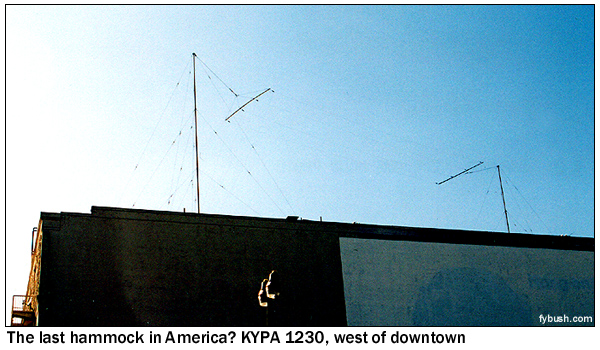 It's
Tower Site
Calendar 2005 season right now here at fybush.com, which
gives us a chance not only to showcase the images featured in
next year's calendar - like the one at right - but also to do
some Very Special Tower Sites of the Week that relate to next
year's calendar images.
It's
Tower Site
Calendar 2005 season right now here at fybush.com, which
gives us a chance not only to showcase the images featured in
next year's calendar - like the one at right - but also to do
some Very Special Tower Sites of the Week that relate to next
year's calendar images.
That unusual antenna at right was first featured here on Site of the Week back in early 2003, when we did "We Love L.A., Part III." It's very possibly the last hammock-type medium-wave antenna in the country, the KYPA (1230 Los Angeles) facility atop the old Odd Fellows Hall just south and west of downtown L.A.
It went into service in 1924, was rebuilt in the early seventies, and went out of use earlier in 2004, when KYPA moved to the KBLA (1580) site near Dodger Stadium. But that site didn't work out as planned, and at least for now, KYPA is back to its original home, which you'll find as Miss November when you order the 2005 calendar. (You have ordered your 2005 calendar, haven't you?)
But here's the neat thing about L.A.: even after three installments of Site of the Week chronicling the broadcast facilities of the Southland, there's always more to see there, especially with one of the market's many experienced and talented engineers as a tour guide.
This past October, en route to the NAB Radio Show in San Diego, Infinity's L.A. director of engineering, Paul Sakrison, was that tour guide, giving your editor a chance to finally fulfill a long-standing dream of touring the legendary CBS Columbia Square facility in Hollywood.
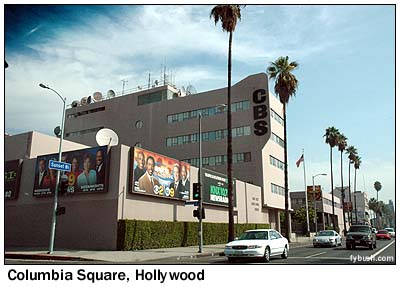 |
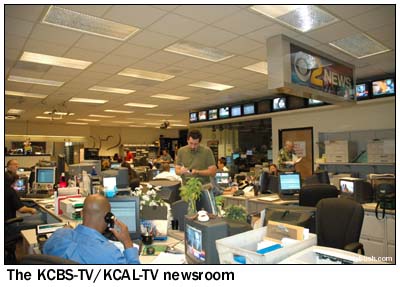
|
We showed you the exterior of the building at 6121 Sunset Boulevard in our 2003 visit to the market, and it wasn't too much later that we heard the news that Viacom planned to sell Columbia Square and to relocate the stations there to new studios elsewhere in Los Angeles. KCBS-FM (93.1) moved out earlier in 2004, joining KROQ (106.7 Pasadena) in the building on Venice Boulevard that used to house KRTH (101.1) and the transmitter of KHJ (930). KRTH, in turn, moved to Melrose, reoccupying the building next door to Paramount Pictures that was once KHJ-AM-FM-TV and had more recently been home to KHJ-TV's successor, KCAL-TV (Channel 9). And KCAL-TV, now part of a Viacom duopoly, moved its operations into Columbia Square, combining its newsroom with that of KCBS-TV (Channel 2).
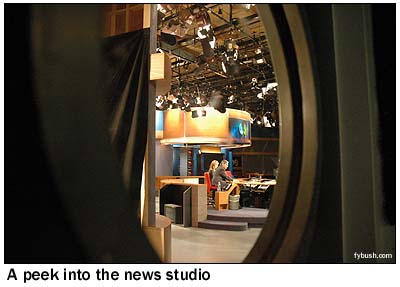 But
we're getting slightly ahead of ourselves, aren't we?
But
we're getting slightly ahead of ourselves, aren't we?
The history of this beautiful Art Deco building began with its other remaining tenant, KNX (1070), which was CBS' West Coast flagship in 1938, when Columbia Square was erected.
Back then, the Sunset side of the building was an open courtyard, where the stars' limousines pulled up to a grand entrance and steps led up to several large audience studios from which most of CBS' West Coast programming originated.
As the framed newspaper articles in the hallway attest, this building was the height of achievement in broadcast facility design in its day, both in technology (it functioned as the West Coast nerve center for the entire CBS network) and design.
It's hard to believe that it was just a few years later that CBS' radio heritage was thoroughly eclipsed by the rise of television - and in particular, at least where Hollywood was concerned, television that required not the sort of small-stage, live-audience facilities that Columbia Square offered but instead the sort of huge soundstages and post-production facilities that owed more to the movies than to radio. So while KNX radio remained at Columbia Square, joined after the war by the minimal local facilities of KNXT (Channel 2), the bulk of CBS' television operations in Los Angeles came not from here but from Studio City and, beginning in the late fifties, the mammoth CBS Television City studios at Beverly and Fairfax, built atop the old Farmers' Market.
Today's visitor to Columbia Square enters from the parking lot in back, through a small lobby that was once the artists' entrance. A former TV studio is now the KCBS-TV/KCAL-TV newsroom, built on two levels just off the lobby. The main hallway of the building runs perpendicular to Sunset, and at the front of the building (now the far end of the hall from the lobby) sit the cafeteria, several editing rooms, and the corridor parallel to Sunset that was once the grand main entrance to the building. The stairs that once led up to the studio now pass master control for channels 2 and 9, before heading back to a newer portion of the building that houses several studios used for KCBS and KCAL's local newscasts. Look carefully at the set above - all the "KCAL 9" signage is on video screens, and as soon as this 11 AM newscast on channel 9 is over, they'll flip to "CBS 2" for the noon news on KCBS!
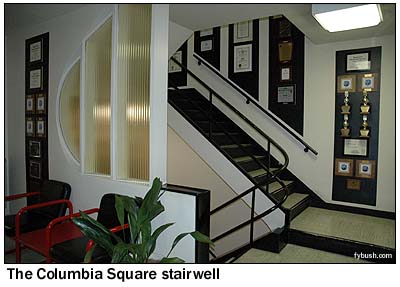 |
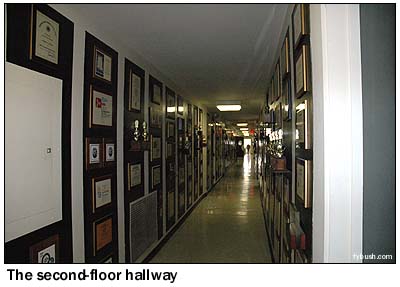
|
KNX's studios are up on the second floor of the surprisingly narrow office tower here, and they're laid out in a sort of a "T" shape along corridors that are encrusted with examples of pretty much every journalism and civic award known to the industry, a testament to KNX's many decades of service to the community.
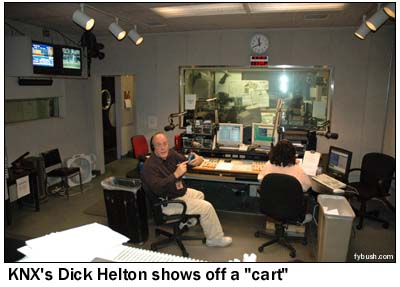 |
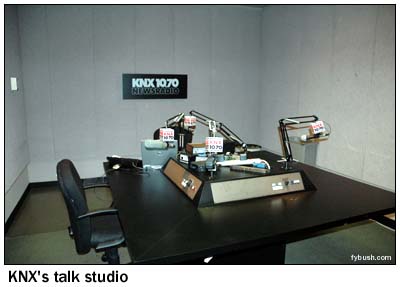
|
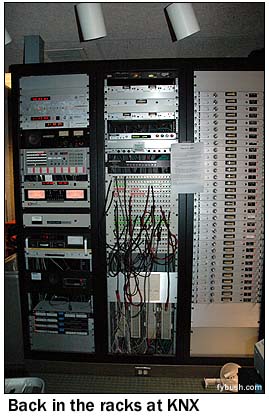
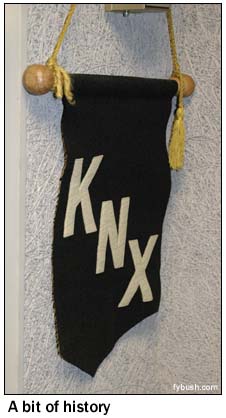 Along the main part
of the corridor, we find the primary KNX air studio, where teams
of two anchors do the news "combo" style, board ops
having long been extinct here. The spots and promos now come
from digital automation, but there's very little else to be seen
here that's digital. A raised platform at the back of the room
houses racks full of patch bays, mod monitors, the transmitter
remote controls, satellite receivers and whatnot.
Along the main part
of the corridor, we find the primary KNX air studio, where teams
of two anchors do the news "combo" style, board ops
having long been extinct here. The spots and promos now come
from digital automation, but there's very little else to be seen
here that's digital. A raised platform at the back of the room
houses racks full of patch bays, mod monitors, the transmitter
remote controls, satellite receivers and whatnot.
Looking down on the main studio area, we see anchor Dick Helton showing us a strange blue rectangular object he describes as a "cart." It's apparently some primitive form of audio storage, still in use for playing news actualities, and we make a mental note to investigate further upon our return home...
The KNX anchors face into a small booth used for traffic reporting, and beyond that sits a production studio, where we spot the nifty banner seen at right. That studio, in turn, looks into the talk studio, which is getting an increasing amount of use as KNX supplements its all-news format with talk shows. On weekends, particularly, much of KNX's airtime is now filled with call-in shows about food and technology, as KNX tries to differentiate itself from erstwhile competitor KFWB, about which much more in just a moment.
A "T" off the main hallway leads back into that large windowless part of the building seen in the left foreground of our exterior view, above. Passing the old "Studio C," now subdivided into several small booths used for editing and phone interviews, we enter the heart of the KNX news operation, the relatively small newsroom whose windows face out over the lobby entrance and the rear parking lot.
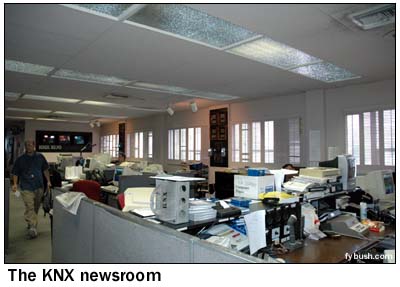 |
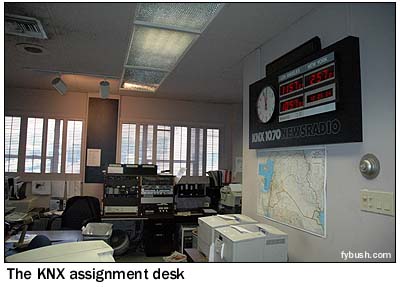
|
Turning to the left just after entering the newsroom, another hallway runs past the intake desk, where incoming news feeds are still recorded on "reels" and "cassettes" (gotta check on what those were, too!) Beyond the intake area, we find two more news studios, one of which is rented out by CBS News for its West Coast network needs, such as they are.
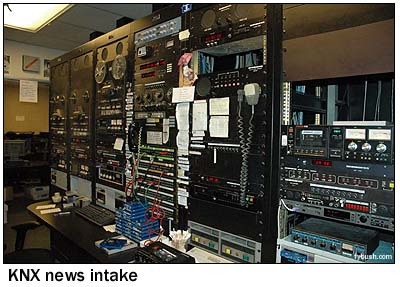 |
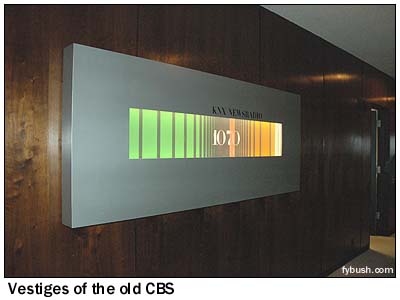
|
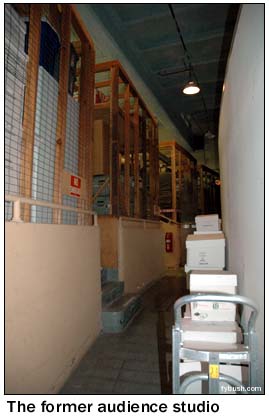
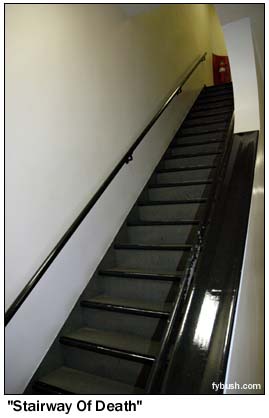 It's
a neat bit of history, but that's nothing compared to
what the next stops on the tour have to offer. The third floor
is home to KNX's executive offices, and that distinguished-looking
wood paneling and sixties-modern International Style design were
the hallmarks of longtime CBS second-in-command Frank Stanton.
(He was responsible for CBS' Black Rock headquarters in New York,
too.)
It's
a neat bit of history, but that's nothing compared to
what the next stops on the tour have to offer. The third floor
is home to KNX's executive offices, and that distinguished-looking
wood paneling and sixties-modern International Style design were
the hallmarks of longtime CBS second-in-command Frank Stanton.
(He was responsible for CBS' Black Rock headquarters in New York,
too.)
The former FM studios on the fourth floor have been completely gutted and replaced by sales offices, and the fifth floor is additional office space. But back to that second floor for a minute - down at the end of the hall, just before the door to the engineering offices (grandiosely labeled "CBS West Coast Engineering"), a corridor leads off to the right into a sloped storage area packed with old paperwork and equipment. So what, you ask? Look more closely - what's a storage area doing with steps and railings like that, anyway?
It turns out that where those storage bins are, there once were seats - and where that wall now partitions off some more TV edit suites, there was once a stage. And it was on that stage that Jack Benny once entertained a nation every week, in this room that was once one of the most prominent radio studios in America.
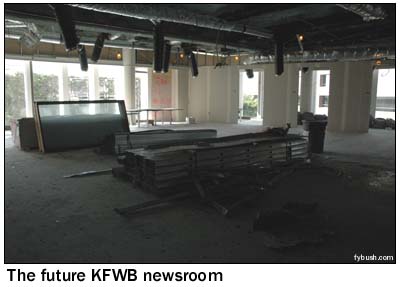 All
things must pass, they say - and so it is with Columbia Square.
The building's showing its considerable age, without doubt; that
steep stairway above at right connects the KNX newsroom hallway
with an engineering corridor on the first floor, but the edges
of those treads have become so smooth after more than six decades
of use that it's now nicknamed "Stairway of Death."
Early in 2005, KNX will leave Columbia Square behind for good
as it joins most of the rest of Infinity's Los Angeles stations
(KTWV 94.7, KLSX 97.1, KRTH 101.1 and KFWB 980) at a new facility
now under construction in a Miracle Mile office tower on Wilshire
Boulevard. In another year or so, KCBS-TV and KCAL-TV will move
to new space in Studio City, and Columbia Square will apparently
have a rendezvous with the wrecking ball, joining other bits
of LA radio legend (NBC at Hollywood and Vine, KFI on Vermont
Avenue) in the history books.
All
things must pass, they say - and so it is with Columbia Square.
The building's showing its considerable age, without doubt; that
steep stairway above at right connects the KNX newsroom hallway
with an engineering corridor on the first floor, but the edges
of those treads have become so smooth after more than six decades
of use that it's now nicknamed "Stairway of Death."
Early in 2005, KNX will leave Columbia Square behind for good
as it joins most of the rest of Infinity's Los Angeles stations
(KTWV 94.7, KLSX 97.1, KRTH 101.1 and KFWB 980) at a new facility
now under construction in a Miracle Mile office tower on Wilshire
Boulevard. In another year or so, KCBS-TV and KCAL-TV will move
to new space in Studio City, and Columbia Square will apparently
have a rendezvous with the wrecking ball, joining other bits
of LA radio legend (NBC at Hollywood and Vine, KFI on Vermont
Avenue) in the history books.
And yes, you did read that correctly - when the new facility on Wilshire is completed, KNX will have only a thin wall separating its operations from those of longtime archrival KFWB. Back in the day (and by "the day," we mean as recently as the mid-nineties, until Westinghouse bought CBS and took its corporate identity, only to be absorbed down the road by Viacom), the CBS all-news stations (WCBS in New York, WBBM in Chicago, KNX in Los Angeles, KCBS in San Francisco) competed fiercely with the Group W all-news cluster that included WINS in New York, WMAQ in Chicago, KYW in Philadelphia, WBZ in Boston and, yes, KFWB here in Los Angeles.
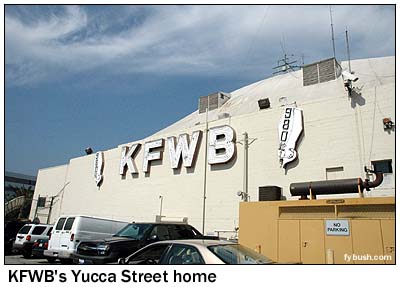 |
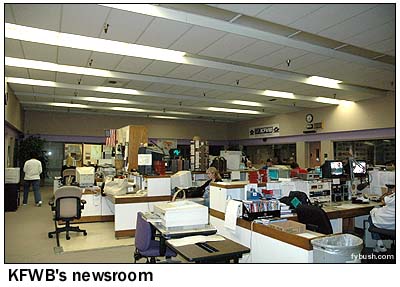
|
If CBS was the big-money, classy network operation, Group W was the tightly-budgeted, scrappy challenger - and one look at KFWB's facility on Yucca Street, just a few blocks from Columbia Square, is enough to tell that story. This building was a supermarket before KFWB moved in in 1976, and that gave Group W lots of room to build a big, column-free newsroom right at the heart of the operation. It's so big, in fact, that sports and business segments come not from a studio but from elevated platforms at either end of the newsroom, looking through those windows on the side into the news studio beyond.
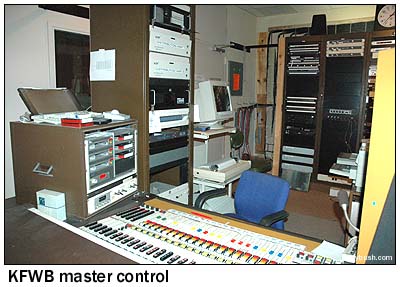 |
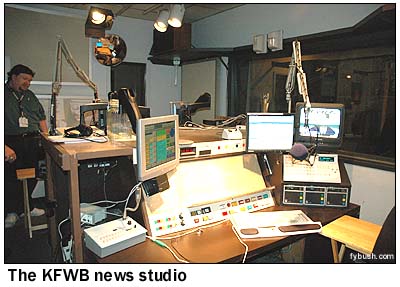
|
There was a time, and not that long ago, when the KFWB anchors had an engineer sitting across the window from them to handle all the technical aspects of their newscasts (those mysterious "cart" things again, apparently) - but no longer, and that creates a rather unique way of handling KFWB's on-air operations today. Look carefully at the (now unmanned) master control board - a prototype Pacific Recorders BMX console, by the way, so early that it doesn't even have any silk-screening on it - and you'll see that every single pot on the board is up. Those pots are remoted into the news studio, where the anchors can turn them on and off, but can't control their levels. That's easier to do these days, with those Enco touchscreens controlling most of the audio here.
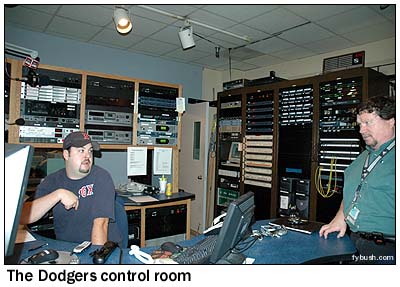 |
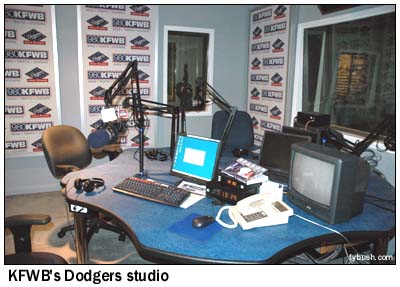
|
Why is the news studio vacant this afternoon? KFWB, like KNX, has begun to diverge a bit from its all-news mission; a few years back, it became the flagship of the Los Angeles Dodgers network, and on this early October afternoon it's carrying a National League divisional series game. The Dodgers network has its own control room adjacent to master control, as well as its own studio (with Dodger-blue countertops) for pre- and post-game shows. And, this being L.A., you're invited to note (as we did, gleefully) what the guy running the Dodgers network this afternoon is wearing...
KFWB has a healthy respect for its own long and fascinating history; its conference room is lined with photos chronicling the station's early days as the Warner Brothers station (hence the "WB" in the calls) and its top-40 "Color Radio" legacy of the fifties and sixties. Will those pictures - and KNX's wall of awards - find a home in the new corporate cluster digs on the Miracle Mile? We can't wait for a chance to return to LA next year to see how things have changed, in this city of constant change.
But in the meantime, we have much, much more to show you from our busy couple of days in the City of Angels. Next week, we head up Mount Wilson to see one of America's most impressive TV/FM sites. We'll see you then!
 It's here - the 2005
Tower Site Calendar is now shipping! Click
here for ordering information!
It's here - the 2005
Tower Site Calendar is now shipping! Click
here for ordering information!
- Previous Site of the Week: Ingraham Hill, Binghamton, N.Y.
- Next Week: We (Still) Love L.A., part II: Mount Wilson
- Site of the Week INDEX!
- How can you help support Site of the Week? Click here!
- Submit your suggestions for a future Site of the Week!
